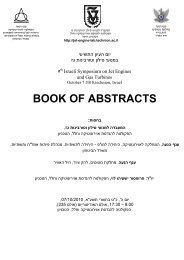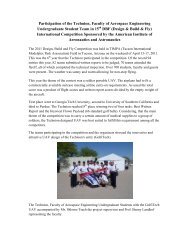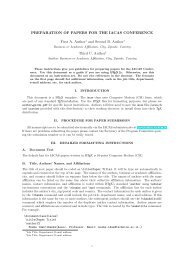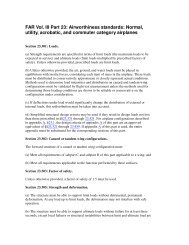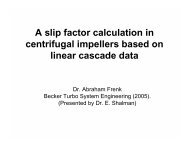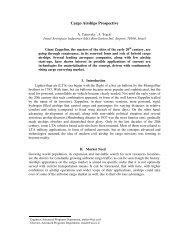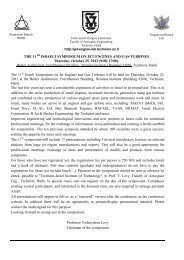A Century of Ramjet Propulsion Technology Evolution - Faculty of ...
A Century of Ramjet Propulsion Technology Evolution - Faculty of ...
A Century of Ramjet Propulsion Technology Evolution - Faculty of ...
Create successful ePaper yourself
Turn your PDF publications into a flip-book with our unique Google optimized e-Paper software.
fuels comes from the atmosphere, the engines produce much higher<br />
engine efficiency over a large portion <strong>of</strong> the flight and a longer<br />
powered range than rockets, there is thrust modulation for efficient<br />
cruise and acceleration, they have the ability to change efficiently<br />
powered fight path and maneuverability, and they are reusable not<br />
just refurbishable. An additional feature for space access is a short<br />
turnaround time, with a potential cost reduction <strong>of</strong> 10–100 times per<br />
pound <strong>of</strong> payload.<br />
Possible applications for scramjets include hypersonic cruise vehicles,<br />
hypervelocity missiles, and airbreathing boosters for space<br />
applications. Hydrogen fuel is desirable for high Mach number applications<br />
due to its high-energy content, fast reactions, and excellent<br />
cooling capabilities. For hypersonic missile applications and airbreathing<br />
systems operating below Mach 6, hydrocarbon fuels are<br />
preferred because <strong>of</strong> volumetric and operational constraints. Making<br />
use <strong>of</strong> the enhanced cooling capabilities <strong>of</strong> endothermic hydrocarbon<br />
fuels can increase the maximum speed for hydrocarbon-fueled<br />
missiles and vehicles to Mach 8. Attractive mission identified for<br />
scramjet-powered vehicles include a Mach 8 cruise missile as a<br />
stand<strong>of</strong>f fast-reaction weapon or long-range cruise missile or boost<br />
propulsion for stand<strong>of</strong>f fast-reaction weapon or airbreathing booster<br />
for space access.<br />
Subsonic Combustion (<strong>Ramjet</strong>) Cycle Behavior<br />
Conceptual schematics <strong>of</strong> subsonic combustion ramjets and hybrid<br />
or combined cycle derivatives are shown in Figs. 3 and 4 following<br />
Waltrup, 5 whose past contributions have been most noteworthy.<br />
Figure 3a shows the traditional can-type ramjet (CRJ), liquid-fueled<br />
ramjet (LFRJ), and gaseous-fueled ramjet (GFRJ) with a tandem<br />
booster attached. A tandem booster is required to provide static and<br />
low-speed thrust, which pure ramjets alone cannot provide. Here,<br />
M0 > M1 > 1, but the air is diffused to a subsonic speed (typically<br />
Mach 0.3–0.4) through a normal shock system before reaching station<br />
4. Fuel is then injected and burned with the air at low subsonic<br />
speeds before reaccelerating through a geometric throat (M5 = 1)<br />
and exit nozzle (M6 > 1). The position <strong>of</strong> the normal shock system<br />
in this and all subsonic combustion ramjets is determined by the<br />
flight speed, air captured, total pressure losses up to the inlet’s terminal<br />
normal shock, amount <strong>of</strong> heat addition, inlet boundary layer<br />
and flow distortion, and exit nozzle throat size.<br />
A more recent alternative to this concept is to use a common<br />
combustion chamber, commonly referred to as an integral rocket<br />
ramjet (IRR), for both the boost and sustain phases <strong>of</strong> flight. This<br />
generally requires a dump-type rather than a can-type combustor,<br />
but the cycle <strong>of</strong> operation <strong>of</strong> the ramjet remains the same. Figure 3b<br />
is a schematic <strong>of</strong> this concept for a liquid-fueled IRR (LFIRR) and<br />
Fig. 3c shows a solid-fueled IRR (SFIRR). In some applications,<br />
SFIRRs are preferred over LFIRRs, GFRJs, or CRJs because <strong>of</strong><br />
the simplicity <strong>of</strong> the fuel supply, but only when the fuel throttling<br />
requirements are minimal, that is, when flight altitude and Mach<br />
FRY 29<br />
Fig. 2 Typical airbreathing flight corridor.<br />
a) Conventional can combustor ramjet (CRJ)<br />
b) Integral rocket/dump combustor ramjet (LFIRR)<br />
c) SFIRR<br />
d) ADR<br />
Fig. 3 Schematics <strong>of</strong> generic ramjet engines.






